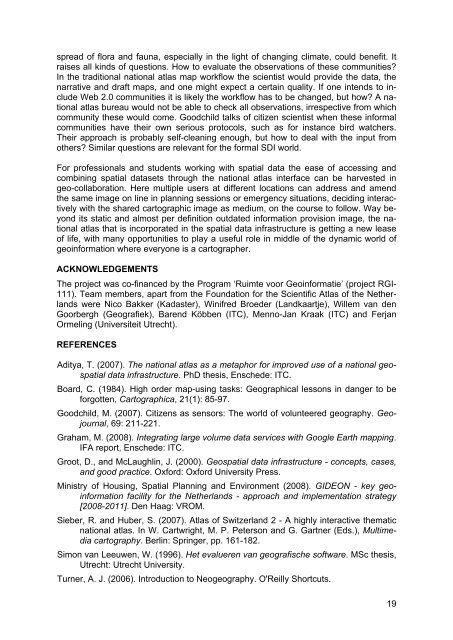SDI Convergence - Global Spatial Data Infrastructure Association
SDI Convergence - Global Spatial Data Infrastructure Association
SDI Convergence - Global Spatial Data Infrastructure Association
You also want an ePaper? Increase the reach of your titles
YUMPU automatically turns print PDFs into web optimized ePapers that Google loves.
spread of flora and fauna, especially in the light of changing climate, could benefit. It<br />
raises all kinds of questions. How to evaluate the observations of these communities?<br />
In the traditional national atlas map workflow the scientist would provide the data, the<br />
narrative and draft maps, and one might expect a certain quality. If one intends to include<br />
Web 2.0 communities it is likely the workflow has to be changed, but how? A national<br />
atlas bureau would not be able to check all observations, irrespective from which<br />
community these would come. Goodchild talks of citizen scientist when these informal<br />
communities have their own serious protocols, such as for instance bird watchers.<br />
Their approach is probably self-cleaning enough, but how to deal with the input from<br />
others? Similar questions are relevant for the formal <strong>SDI</strong> world.<br />
For professionals and students working with spatial data the ease of accessing and<br />
combining spatial datasets through the national atlas interface can be harvested in<br />
geo-collaboration. Here multiple users at different locations can address and amend<br />
the same image on line in planning sessions or emergency situations, deciding interactively<br />
with the shared cartographic image as medium, on the course to follow. Way beyond<br />
its static and almost per definition outdated information provision image, the national<br />
atlas that is incorporated in the spatial data infrastructure is getting a new lease<br />
of life, with many opportunities to play a useful role in middle of the dynamic world of<br />
geoinformation where everyone is a cartographer.<br />
ACKNOWLEDGEMENTS<br />
The project was co-financed by the Program ‘Ruimte voor Geoinformatie’ (project RGI-<br />
111). Team members, apart from the Foundation for the Scientific Atlas of the Netherlands<br />
were Nico Bakker (Kadaster), Winifred Broeder (Landkaartje), Willem van den<br />
Goorbergh (Geografiek), Barend Köbben (ITC), Menno-Jan Kraak (ITC) and Ferjan<br />
Ormeling (Universiteit Utrecht).<br />
REFERENCES<br />
Aditya, T. (2007). The national atlas as a metaphor for improved use of a national geospatial<br />
data infrastructure. PhD thesis, Enschede: ITC.<br />
Board, C. (1984). High order map-using tasks: Geographical lessons in danger to be<br />
forgotten, Cartographica, 21(1): 85-97.<br />
Goodchild, M. (2007). Citizens as sensors: The world of volunteered geography. Geojournal,<br />
69: 211-221.<br />
Graham, M. (2008). Integrating large volume data services with Google Earth mapping.<br />
IFA report, Enschede: ITC.<br />
Groot, D., and McLaughlin, J. (2000). Geospatial data infrastructure - concepts, cases,<br />
and good practice. Oxford: Oxford University Press.<br />
Ministry of Housing, <strong>Spatial</strong> Planning and Environment (2008). GIDEON - key geoinformation<br />
facility for the Netherlands - approach and implementation strategy<br />
[2008-2011]. Den Haag: VROM.<br />
Sieber, R. and Huber, S. (2007). Atlas of Switzerland 2 - A highly interactive thematic<br />
national atlas. In W. Cartwright, M. P. Peterson and G. Gartner (Eds.), Multimedia<br />
cartography. Berlin: Springer, pp. 161-182.<br />
Simon van Leeuwen, W. (1996). Het evalueren van geografische software. MSc thesis,<br />
Utrecht: Utrecht University.<br />
Turner, A. J. (2006). Introduction to Neogeography. O'Reilly Shortcuts.<br />
19

















